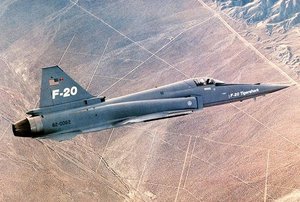F-20 Tigershark
|
|
| F-20 Tigershark | ||
|---|---|---|
 F-20 Tigershark | ||
| Description | ||
| Role | Fighter | |
| Crew | One | |
| Dimensions | ||
| Length | 46 ft 6 in | 14.2 m |
| Wingspan | 26 ft 8 in | 8.1 m |
| Height | 13 ft 10 in | 4.2 m |
| Wing area | 186 ft² | 17 m² |
| Weights | ||
| Empty | 11,220 lb | 5090 kg |
| Loaded | 15,060 lb | 6830 kg |
| Maximum take-off | 26,290 lb | 11920 kg |
| Powerplant | ||
| Engines | One General Electric F404-GE-100 | |
| Thrust | 17,000 lbf | 76 kN |
| Performance | ||
| Maximum speed | Mach 2.1 | |
| Combat radius | 345 mi | 555 km |
| Ferry range | 1,715 mi | 2760 km |
| Service ceiling | 55,000 ft | 16800 m |
| Rate of climb | 50,030 ft/min | 15250 m |
| Armament | ||
| Guns | 2 x 20 mm M39 cannon | |
| Missiles | 2 AIM-9 Sidewinder air-to-air missiles | |
| Bombs | 8,000 lb | 3,600 kg |
F-20 Tigershark was a privately financed fighter aircraft, designed and built by Northrop in the USA, starting in 1975. It was a further evolution of Northrop's F-5 Freedom Fighter (in fact it was originally designated F-5G), although ultimately it shared little more than a strong family resemblance to that aircraft. The main change was the replacement of the F-5's two General Electric J85 engines with a single General Electric F404 turbofan, increasing its total thrust by 60%. Like the F-5, however, it was designed as a low-cost, high-performance fighter plane that was easy to maintain. It could reach speeds of Mach 2.1 and had a ferry range of 1,715 miles (2760 km).
The F-20 made its first flight on August 30, 1982, and a total of three prototypes were created. It was intended for sale to foreign countries and militaries, but the market for the plane never developed, as President Ronald Reagan relaxed the restrictions on selling fighters such as the F-16 Fighting Falcon to other countries. After six years and no major buyers, Northrop cancelled the $1.2 billion project. Air forces that could afford the F-20 bought the F-16, while ones which could buy neither, purchased the cheaper F-5E/F Tiger II or the Russian MiG-21. While its performance was comparable to the Block 1/5/10 F-16 Viper and superior to the turbojet-powered export-variant F-16/79, the F-20 airframe had virtually no remaining expansion capability, as it was built on essentially a 20 year old airframe at the limits of its capabilities. The F-16, on the other hand, was a brand-new jet that had not even begun to approach its eventual capabilities. There was speculation within the F-20 development team that the US Air Force influenced foreign militaries to buy the F-16, in order to make spare parts more available.
The last existing F-20 is on display at the California Science Center. The other two prototypes were lost due to crashes during world sales tours. The crashes were caused by pilot error, and were not linked to any malfunction of the planes.
Aerospace legend Chuck Yeager, who worked as a spokesperson for Northrop during the F-20's development, frequently touted the plane and was regularly featured in its advertising.
Quotes
"The F-20 impressed everybody but the people it was supposed to."
External links
- California Science Center - F-20 Tigershark exhibit (http://www.casciencectr.org/Exhibits/AirAndSpace/AirAndAircraft/F20/F20.php)
- F-20 Tigershark information and chronology (http://members.aon.at/mwade/)
| Related content | |
|---|---|
| Related development | |
| Similar aircraft | |
| Designation series | |
| Related lists | List of military aircraft of the United States - List of fighter aircraft |
|
Lists of Aircraft | Aircraft manufacturers | Aircraft engines | Aircraft engine manufacturers Airports | Airlines | Air forces | Aircraft weapons | Missiles | Timeline of aviation |
